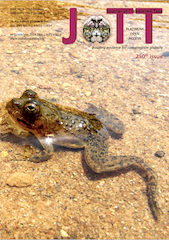Insights into the diet and feeding behaviour of Red-capped Lark Calandrella cinerea (Aves: Passeriformes: Alaudidae)
Main Article Content
Abstract
Anthropogenic activities have continued to threaten critical habitats of many tropical birds. Few studies, however, have established the habitat requirements, diet and foraging strategies of the threatened species to guide conservation efforts. The Red-capped Lark Calandrella cinerea, which inhabits tropical grasslands in Africa is highly threatened by habitat loss and anthropogenic activities such as burning for pasture regeneration and overgrazing by livestock. Many aspects of the feeding behaviour of this threatened tropical lark are still unknown. We studied the diet and feeding behaviour of the adult Red-capped Lark in its open grassland habitat at Kedong, Naivasha, Kenya from 04 March 2016 to 12 August 2016. Findings revealed that birds predominantly consumed animal nutrients that included insect larvae/caterpillars, grasshoppers, moths/butterflies, ants, and beetles. This was supplemented with plant nutrients (grass seeds) from two grass species, Eragrostis tenuifolia and Harpachne schimperi. Picking and gulping were the most employed food capture and handling techniques respectively. In relation to foraging substrates, grass substrate was most selected for food capture as compared to large mammal dung and soil mounds. Given that tropical grasslands are becoming increasingly threatened biomes, the findings are critical in guiding the management of grassland habitats of birds to ensure their protection from negative impacts as well as deepen understanding on how they adapt to environmental changes.
Article Details
Authors own the copyright to the articles published in JoTT. This is indicated explicitly in each publication. The authors grant permission to the publisher Wildlife Information Liaison Development (WILD) Society to publish the article in the Journal of Threatened Taxa. The authors recognize WILD as the original publisher, and to sell hard copies of the Journal and article to any buyer. JoTT is registered under the Creative Commons Attribution 4.0 International License (CC BY), which allows authors to retain copyright ownership. Under this license the authors allow anyone to download, cite, use the data, modify, reprint, copy and distribute provided the authors and source of publication are credited through appropriate citations (e.g., Son et al. (2016). Bats (Mammalia: Chiroptera) of the southeastern Truong Son Mountains, Quang Ngai Province, Vietnam. Journal of Threatened Taxa 8(7): 8953–8969. https://doi.org/10.11609/jott.2785.8.7.8953-8969). Users of the data do not require specific permission from the authors or the publisher.

